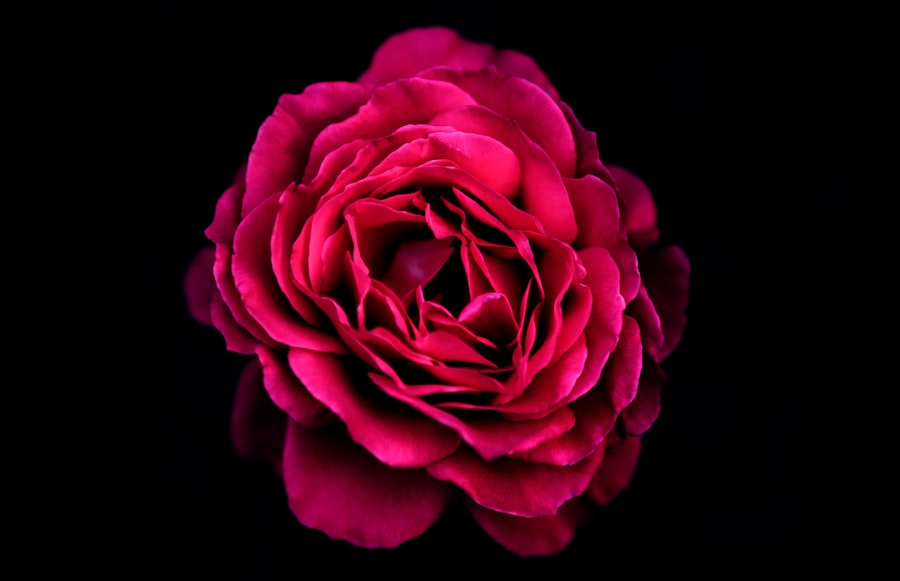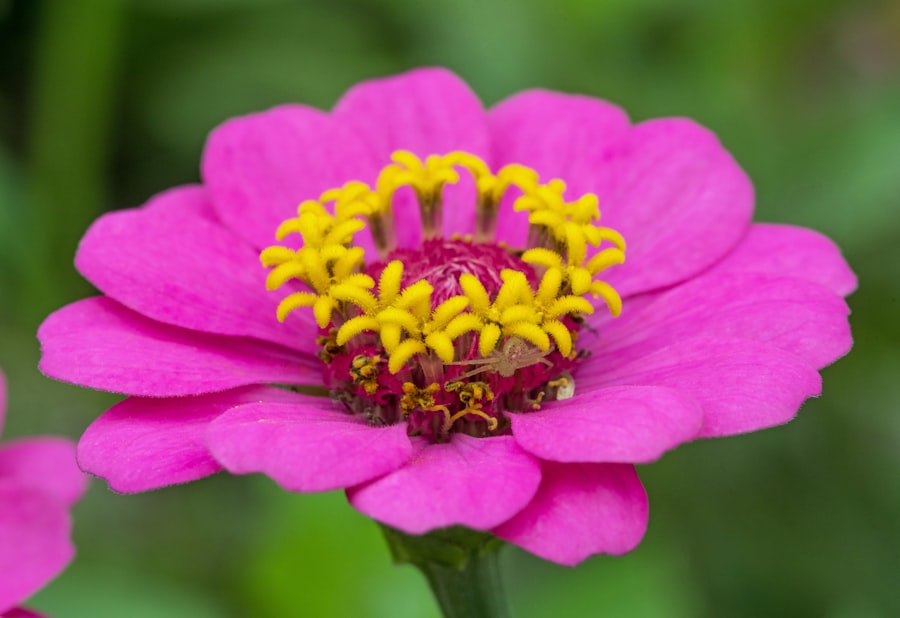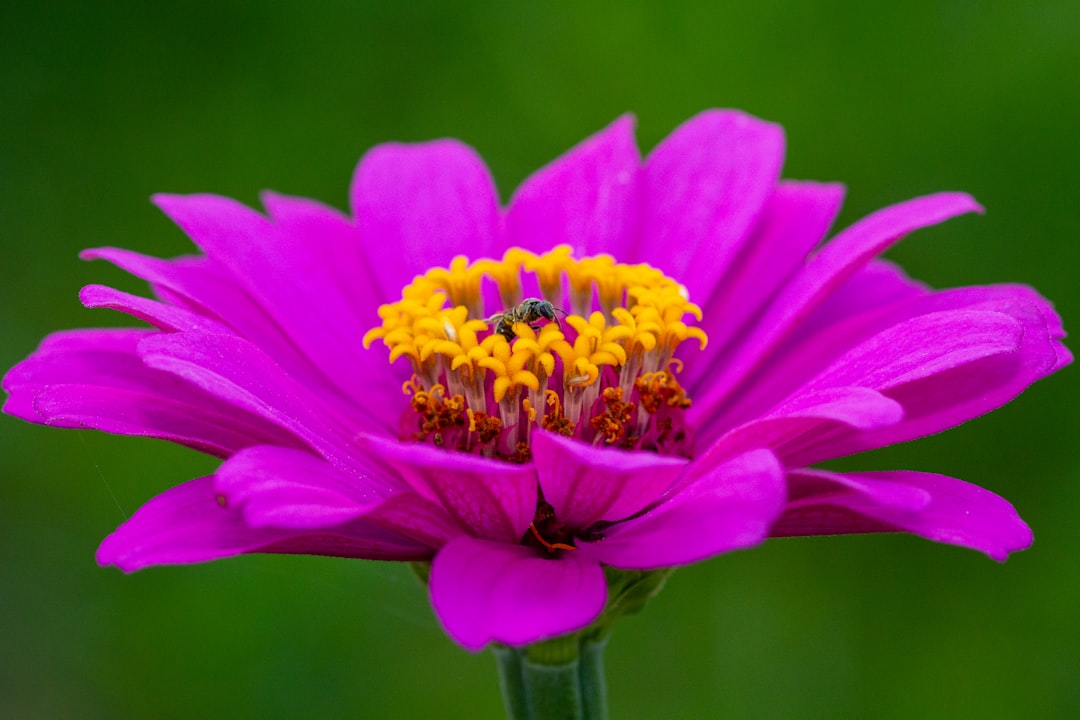Zinnias are vibrant, cheerful flowers that bring a splash of color to any garden. Belonging to the Asteraceae family, these annuals are native to Mexico and come in a variety of shapes, sizes, and colors. From the classic daisy-like blooms to the more intricate pom-pom varieties, zinnias are beloved by gardeners for their resilience and beauty.
They thrive in sunny spots and are known for attracting butterflies and bees, making them a wonderful addition to any pollinator-friendly garden. One of the most appealing aspects of zinnias is their ease of growth. They are forgiving plants that can flourish in a range of soil types, provided they receive adequate sunlight and water.
With their long-lasting blooms, zinnias can brighten up your garden from late spring until the first frost. Whether you’re a seasoned gardener or just starting out, zinnias offer a delightful way to connect with nature and enjoy the beauty of flowers.
Key Takeaways
- Zinnias are colorful and easy-to-grow annual flowers that come in a variety of shapes and sizes, making them a popular choice for gardeners.
- Planting zinnias in spring allows for earlier blooms and a longer flowering period, while planting in early summer can result in a later but equally vibrant display of flowers.
- Spring planting provides zinnias with cooler temperatures and more consistent moisture, while early summer planting benefits from warmer soil and longer daylight hours.
- When planting zinnias in spring, it is important to consider the risk of late frosts and the need for adequate soil preparation and drainage.
- Planting zinnias in early summer requires attention to watering needs, protection from intense heat, and potential pest control measures.
Advantages of Planting Zinnias in Spring
Planting zinnias in spring has several advantages that can enhance your gardening experience. First and foremost, spring is a time of renewal and growth. As the days grow longer and warmer, zinnias respond beautifully to the increasing sunlight.
This season provides the perfect conditions for germination, allowing zinnia seeds to sprout and establish strong roots before the heat of summer sets in. By planting in spring, you can enjoy a longer blooming period, as these flowers will have ample time to grow and flourish. Additionally, spring planting allows you to take advantage of the natural rainfall that often accompanies this season.
Young zinnia plants benefit from consistent moisture, which helps them establish themselves without the need for excessive watering. This not only saves you time and effort but also promotes healthier plants that are better equipped to withstand dry spells later in the summer. With vibrant blooms emerging early in the season, your garden will be a source of joy and beauty as you watch it come alive.
Advantages of Planting Zinnias in Early Summer

While spring is an excellent time to plant zinnias, early summer also offers unique benefits. For those who may have missed the spring planting window or are looking to refresh their garden, early summer is a great opportunity to sow zinnia seeds directly into the soil. The warm temperatures during this time encourage rapid germination, allowing you to see results quickly.
This can be particularly rewarding for gardeners eager to see their efforts bloom. Moreover, planting zinnias in early summer can help extend your garden’s blooming season. If you stagger your planting times, you can enjoy fresh blooms throughout the summer months.
This technique not only keeps your garden looking vibrant but also provides continuous food sources for pollinators. By planting zinnias at different times, you create a dynamic landscape that evolves with the seasons, offering a feast for both the eyes and the local wildlife.
Considerations for Planting Zinnias in Spring
| Considerations for Planting Zinnias in Spring | |
|---|---|
| 1. Soil Type | Well-drained, fertile soil |
| 2. Sunlight | Full sun (at least 6 hours per day) |
| 3. Watering | Regular watering, allowing soil to dry between waterings |
| 4. Planting Depth | 1/4 inch to 1/2 inch deep |
| 5. Spacing | 6 to 18 inches apart, depending on variety |
| 6. Fertilization | Use a balanced fertilizer every 4-6 weeks |
| 7. Pests and Diseases | Monitor for aphids, spider mites, and powdery mildew |
When considering planting zinnias in spring, it’s essential to pay attention to your local climate and frost dates. Zinnias thrive in warm weather, so it’s crucial to wait until all danger of frost has passed before sowing seeds outdoors. In many regions, this typically occurs after mid-April or early May.
To ensure successful germination, you can start seeds indoors a few weeks before the last frost date and then transplant them outside once conditions are favorable. Soil preparation is another vital consideration when planting zinnias in spring. These flowers prefer well-draining soil enriched with organic matter.
Before planting, consider amending your garden bed with compost or well-rotted manure to provide essential nutrients. Additionally, ensure that your chosen location receives at least six hours of direct sunlight each day. By taking these steps, you’ll create an ideal environment for your zinnias to thrive.
Considerations for Planting Zinnias in Early Summer
If you decide to plant zinnias in early summer, there are a few key factors to keep in mind. First, be aware of the heat levels in your area during this time. While zinnias love warmth, extreme temperatures can stress young plants.
If you live in a particularly hot climate, consider planting in the late afternoon or evening when temperatures are cooler. This will help protect your seedlings from heat stress as they establish themselves. Another important consideration is watering.
Early summer can bring dry spells, so it’s crucial to monitor soil moisture closely after planting. Newly sown seeds need consistent moisture to germinate successfully. However, be careful not to overwater; zinnias prefer slightly dry conditions once established.
A good rule of thumb is to water deeply but infrequently, allowing the soil to dry out between waterings. This approach encourages strong root development and helps prevent diseases associated with overly wet conditions.
Ideal Growing Conditions for Zinnias

Ideal Sunlight Conditions
These flowers love full sun—at least six hours of direct sunlight each day is optimal. This exposure not only promotes healthy growth but also enhances the vibrancy of their blooms.
Soil Quality and Drainage
If you’re planting zinnias in a garden bed or container, choose a location that receives plenty of sunlight throughout the day. Soil quality is equally important for zinnia growth. They prefer well-draining soil with a pH level between 6.0 and 7.0. If your soil is heavy clay or too sandy, consider amending it with organic matter like compost or peat moss to improve drainage and nutrient content.
Watering and Drought Tolerance
Additionally, zinnias are relatively drought-tolerant once established but will benefit from regular watering during dry spells—especially when they are young and still developing their root systems.
Tips for Planting Zinnias in Spring
When planting zinnias in spring, there are several tips that can help ensure success. First, consider starting seeds indoors if you want to get a head start on the growing season. Use seed trays filled with seed-starting mix and place them in a warm location with plenty of light.
Once seedlings have developed two sets of true leaves and all danger of frost has passed, they can be transplanted outdoors. When sowing seeds directly into the garden bed, space them about 12 inches apart to allow for proper air circulation and growth. This spacing helps prevent overcrowding and reduces the risk of fungal diseases that can occur when plants are too close together.
After planting, gently water the area to settle the soil around the seeds without washing them away.
Tips for Planting Zinnias in Early Summer
For those opting to plant zinnias in early summer, timing is key. Choose a day when temperatures are moderate for planting; this will help reduce stress on young plants as they acclimate to their new environment. If possible, prepare your garden bed ahead of time by loosening the soil and adding organic matter to create a nutrient-rich foundation.
When sowing seeds or transplanting seedlings during early summer, be sure to water them thoroughly after planting. This initial watering helps settle the soil around the roots and provides moisture needed for germination or establishment. Additionally, consider using mulch around your newly planted zinnias; this will help retain soil moisture and suppress weeds as they grow.
Common Mistakes to Avoid When Planting Zinnias
Even experienced gardeners can make mistakes when planting zinnias, so it’s essential to be aware of common pitfalls. One frequent error is planting too early in the season before the last frost has passed. Zinnia seeds are sensitive to cold temperatures; if exposed to frost, they may fail to germinate or suffer damage that stunts their growth.
Another mistake is overwatering or underwatering your zinnias. While these flowers appreciate consistent moisture during their early stages, too much water can lead to root rot and other issues. Conversely, allowing them to dry out completely can hinder their growth and flowering potential.
Striking a balance with watering is crucial for healthy plants.
Maintenance and Care for Zinnias
Once your zinnias are established, ongoing maintenance is relatively simple but essential for keeping them healthy and vibrant throughout the growing season. Regular deadheading—removing spent blooms—encourages new flowers to form and prolongs the blooming period. This practice not only keeps your garden looking tidy but also promotes bushier growth as plants redirect energy toward producing new blooms.
Fertilizing is another important aspect of zinnia care. While these flowers don’t require heavy feeding, applying a balanced fertilizer every four to six weeks can enhance their growth and flowering potential. Be sure to follow package instructions carefully; over-fertilizing can lead to lush foliage at the expense of blooms.
Choosing the Best Time to Plant Zinnias
In conclusion, whether you choose to plant zinnias in spring or early summer depends on your local climate and personal gardening goals. Spring offers an extended growing season with cooler temperatures that promote strong root development, while early summer provides an opportunity for quick germination and continuous blooms throughout the season. By understanding the unique advantages and considerations of each planting time, you can make an informed decision that aligns with your gardening style.
Ultimately, zinnias are a wonderful choice for any garden enthusiast looking to add color and attract pollinators while enjoying nature’s beauty firsthand. With proper care and attention, these resilient flowers will reward you with stunning displays that brighten your outdoor space all summer long. FAQ Section 1.
How often should I water my zinnia plants?
Zinnia plants prefer consistent moisture but do not like soggy soil. Water deeply once or twice a week depending on weather conditions; allow the top inch of soil to dry out between waterings. 2.
Can I grow zinnias in containers?
Yes! Zinnias grow well in containers as long as they have enough space (at least 12 inches apart) and receive plenty of sunlight. 3.
What pests should I watch out for when growing zinnias?
Common pests include aphids and spider mites; regular monitoring and using insecticidal soap can help manage these issues effectively. 4. How do I know when my zinnia seeds are ready for harvest?
Zinnia seeds are ready for harvest when the flower heads turn brown and dry out completely on the plant; simply cut off the heads and store them in a cool, dry place.
5. Can I save zinnia seeds for next year?
Absolutely!
6. Are zinnias deer-resistant?
While no plant is entirely deer-proof, zinnias are generally considered deer-resistant due to their strong scent and taste; however, hungry deer may still nibble on them if food is scarce. 7.
Do zinnias attract beneficial insects?
Yes! Zinnias attract pollinators like bees and butterflies while also drawing beneficial insects such as ladybugs that help control pest populations in your garden.
If you are looking for more gardening tips, you may want to check out this article on when is the best time to plant zinnias. It provides valuable information on the ideal timing for planting these beautiful flowers to ensure they thrive in your garden. Additionally, you can also explore articles on topics such as caring for curly hair plants (https://chikusgarden.com/curly-hair-plant/) and pruning dappled willow bushes (https://chikusgarden.com/dappled-willow-bush-pruning/) to enhance your gardening knowledge further.
FAQs
What are zinnias?
Zinnias are colorful and easy-to-grow annual flowers that are popular in gardens and landscapes. They come in a variety of vibrant colors and are known for their long-lasting blooms.
When is the best time to plant zinnias?
The best time to plant zinnias is in the spring, after the last frost has passed and the soil has warmed up. This is typically around late April to early May, depending on your location.
Can zinnias be planted in the fall?
Zinnias are sensitive to cold temperatures and are typically planted in the spring and summer. However, in warmer climates, zinnias can be planted in the fall for a late-season bloom.
How long do zinnias take to bloom after planting?
Zinnias typically take about 60 to 70 days to bloom after planting. However, this can vary depending on the specific variety of zinnia and growing conditions.
What are the ideal growing conditions for zinnias?
Zinnias thrive in full sun and well-drained soil. They are relatively drought-tolerant once established and benefit from regular deadheading to encourage continuous blooming.
Can zinnias be grown in containers?
Yes, zinnias can be grown in containers as long as the containers have good drainage and the plants receive adequate sunlight and water. Container-grown zinnias may require more frequent watering than those planted in the ground.

